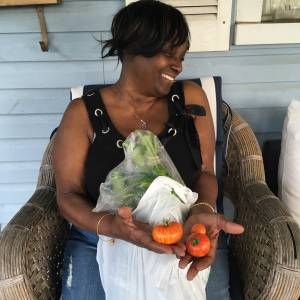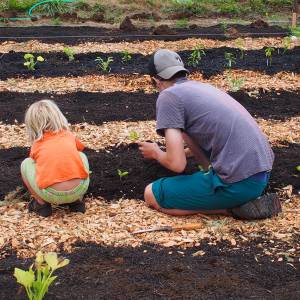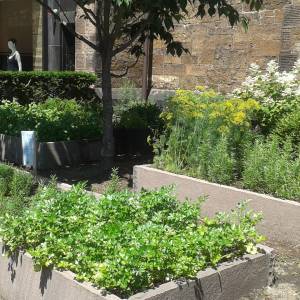Interview with Rev. Karen Hagen, pastor of Tippecanoe Presbyterian Church in Milwaukee, Wisconsin about their new Rooftop Garden
You’ve had a community garden going for a few years now, but tell us about this new initiative.
Our Rooftop Garden has been completed and is growing with harvest coming. Education around the gardens has included the Webinar, local newspaper, garden blessing, and upcoming canning and food use in Divine Intervention’s food programing. We are participating in our synod’s just.good.food program as well.
How did you do it?
Approximately 14 volunteers worked on the Rooftop Garden installation, approximately 20 are working in our other gardens and maintain Rooftop Garden. Primary responsibility for garden care falls upon our Garden Keepers who are homeless and formerly homeless Guests of our Divine Intervention Ministry. Already we have approximately 100 lbs. of organic produce given away. We have developed relationships with 4 funders, 2 restaurants interested in produce grown locally, and 1 local greenhouse that will help us look forward to next enhancements.
Anything surprising happen?
More volunteers than anticipated and a deepening relationship with our neighborhood! One of the unexpected challenges came in relying on one of our partners to coordinate different aspects of the installation of Rooftop Garden. As we move to next aspects of our gardens, we will be proactive in taking on this role ourselves.
Do you have any recommendations for others that may want to try something similar?
Partnerships are key not only in accomplishing but maintaining the gardens. Continually inviting new people to become involved is important to maintain support as key volunteers may need to limit or change their volunteerism with project. Think forward!
Has this project changed your church or community in any way?
Yes! It has allowed us to see what is possible as we stay faithful to our vision and think and partner creatively. And, quite unexpectedly, new attention from the greater community is coming toward Tippecanoe in support and visitors to worship.
Here is the newspaper article about the initiative:
Two Milwaukee churches growing food & jobs
Read more »
 This reflection comes to us from AJ Bisesi, Community Engagement Coordinator for Garfield Community Farm, a ministry of The Open Door Presbyterian Church. Getting produce to our neighbors is an integral tenet of our organization’s mission. We distribute produce in multiple ways, including donating. Valley View Presbyterian Church, one of our church partners from the… Read more »
This reflection comes to us from AJ Bisesi, Community Engagement Coordinator for Garfield Community Farm, a ministry of The Open Door Presbyterian Church. Getting produce to our neighbors is an integral tenet of our organization’s mission. We distribute produce in multiple ways, including donating. Valley View Presbyterian Church, one of our church partners from the… Read more »
 This reflection comes to us from AJ Bisesi, Community Engagement Coordinator for Garfield Community Farm, a ministry of The Open Door Presbyterian Church. Getting produce to our neighbors is an integral tenet of our organization’s mission. We distribute produce in multiple ways, including donating. Valley View Presbyterian Church, one of our church partners from the… Read more »
This reflection comes to us from AJ Bisesi, Community Engagement Coordinator for Garfield Community Farm, a ministry of The Open Door Presbyterian Church. Getting produce to our neighbors is an integral tenet of our organization’s mission. We distribute produce in multiple ways, including donating. Valley View Presbyterian Church, one of our church partners from the… Read more »
 This reflection comes from Bruce Kelsh, Chair of Earth and Social Justice Committee for First Presbyterian Church, in Cottage Grove, OR. Fifty percent of the people in our rural community are classified as being in poverty or ALICE (Asset Limited Income Constrained), that is, the working poor. There is a shortage of fresh produce for…
This reflection comes from Bruce Kelsh, Chair of Earth and Social Justice Committee for First Presbyterian Church, in Cottage Grove, OR. Fifty percent of the people in our rural community are classified as being in poverty or ALICE (Asset Limited Income Constrained), that is, the working poor. There is a shortage of fresh produce for… 

